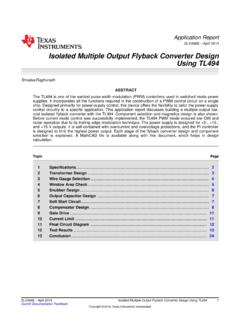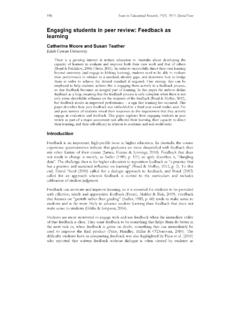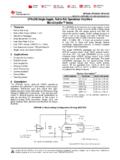Transcription of DEVELOPMENT RESULTS - OECD
1 DEVELOPMENT RESULTS AN OVERVIEW OF RESULTS MEASUREMENT AND MANAGEMENT DEVELOPMENT RESULTSAn Overview of RESULTS Measurement and Management Briefing Note1. Introduction DEVELOPMENT co-operation has always been intended to deliver RESULTS , aiming at supporting economic and social DEVELOPMENT in developing countries and producing tangible improvements in the lives of the poor. Recent trends have intensified global efforts to better manage for DEVELOPMENT RESULTS , driven both by the need to hold decision makers accountable and a growing interest in better understanding how DEVELOPMENT interventions work and how to make them work better. From the Paris Declaration to the Accra Agenda for Action, and more recently the 2011 High Level Forum on Aid Effectiveness in Busan, there has been a great deal of momentum and political interest in DEVELOPMENT RESULTS .
2 Through these international high level fora, commitments on RESULTS management were made, calling on DEVELOPMENT agencies and partner countries to work together to manage resources for the achievement of DEVELOPMENT objectives. A wide range of national and international initiatives and multiple stakeholders call on governments to be more RESULTS focused and transparent. At the international level, the MDGs call for a RESULTS based approach with defined goals to be achieved by 2015. In donor countries tax-payers are demanding their governments show how public spending is contributing to DEVELOPMENT . Citizens and civil society organisations in many developing countries are becoming increasingly demanding of their leaders, looking for clear RESULTS of public spending and policies. In a climate of rapid change and fiscal retrenchment, these factors have put pressure on DEVELOPMENT co-operation agencies to demonstrate that aid is actually working to combat poverty.
3 The idea of focusing on RESULTS seems quite straight forward. It is about systematically gathering and analysing information to understand whether institutions, policies and programmes are working effectively and efficiently and how improvements can be made for future performance. In reality, the application of RESULTS based management approaches has not been simple. With all its complexities, the RESULTS agenda really only matters if it contributes to long term sustainable improvements in the lives of the world s poor and not just changes in the ways in which DEVELOPMENT practitioners manage projects and programmes. This note outlines key concepts, challenges and areas for further exploration. It provides a short summary on some of the uses for RESULTS information, and essential components in the RESULTS management process.
4 It highlights issues and challenges faced by DEVELOPMENT agencies at present. It also provides some information on RESULTS based financing, a new approach to delivering aid of interest among many DEVELOPMENT agencies. 2. RESULTS information for different purposesResults information is needed at different levels (political, institutional, partner country, programme and project management), and at different stages of the programme cycle. The following list provides information on how RESULTS data can be used by DEVELOPMENT practitioners 1: Examples from DAC membersAustraliaIn Australia reports on DEVELOPMENT cooperation RESULTS are presented to parliament and to the public. This reporting mostly focuses on successes and lessons. At the institutional level, Australia has established a new performance management and evaluation policy. This policy has three central elements: learning, management and accountability and assesses progress on a number of levels: against high level DEVELOPMENT outcomes ( MDGs); against outcomes at the partner country level linked to five strategic goals; and against operational and organisational effectiveness of corporate and other processes which contribute to building an enabling environment in which to achieve DEVELOPMENT RESULTS .
5 Management of programmes and projects at the country level includes planning, budgeting and monitoring processes which are RESULTS -oriented and include output and outcome indicators. Sweden In Sweden, reports on RESULTS are sent to Parliament on an annual basis. Sweden invests and plans for communicating RESULTS and is open with the public about the successes and failures of its aid activities. At the strategic level, Sweden uses RESULTS frameworks to monitor strategic objectives. Sweden also uses information from RESULTS reporting to inform decision making in strategic management. Sweden is currently aiming to streamline its objectives through the creation of a set of high level indicators which will aggregate progress across all of its DEVELOPMENT cooperation. It is hoped that this will assist with linking programme outcomes better with expected country strategy outcomes.
6 In addition, Sweden has recently created a new computerised contribution management system which should make RESULTS and risk monitoring and analysis more systematic through all stages of the programme cycle for better RESULTS management. Sweden is developing new country strategies which are currently being piloted in Zambia and Tanzania. Source: OECD DAC Peer Reviews 20133. Essential components in RESULTS managementResults management can be seen as a process with several components: planning, budgeting, implementation, monitoring, and is the process used to define an organisation s direction in the pursuit of a particular goal. Goals should be mutually agreed between partner countries and DEVELOPMENT agencies. Planning includes the clear articulation of what is intended to be High-level political accountability and RESULTS reportingInstitutional accountablity( DEVELOPMENT agencies); policyand strategic managementManagement andimprovement of programmes, projects and policy Accountability to parliament External communication Policy DEVELOPMENT Reporting to management Tracking progress Decision making Lesson learning Reporting to beneficiariesDEVELOPMENT RESULTS AN OVERVIEW OF RESULTS MEASUREMENT AND MANAGEMENT Box 2: OECD DAC DefinitionsAccountability: Obligation to demonstrate that work has been conducted in compliance with agreed rules and standards or to report fairly and accurately on performance RESULTS mandates roles and/or plans.
7 Baseline Study: An analysis describing the situation prior to a DEVELOPMENT intervention, against which progress can be assessed or comparisons made. Benchmark: Reference point or standards against which performance or achievement can be assessed. Effect: Intended or unintended change due directly or indirectly to an intervention. Effectiveness: The extent to which the DEVELOPMENT intervention s objectives were achieved, or are expected to be achieved, taking into account their relative importance. Note: Also used as an aggregate measure of (or judgement about) the merit or worth of an : A measure of how economically resources/inputs (funds, expertise, time etc.) are converted to RESULTS . Indicator: Quantitative or qualitative factor or variable that provides a simple, and reliable, means to measure achievement, to reflect the changes connected to an intervention, or to help assess the performance of a DEVELOPMENT actor.
8 Impact: Positive and negative, primary and secondary long term effects produced by a DEVELOPMENT intervention, directly or indirectly, intended or : The output, outcome or impact (intended or unintended, positive and/or negative) of a DEVELOPMENT intervention. The RESULTS chain is often used as a model to help us think through how the resources we provide and activities we are engaged in are meant to produce certain desired changes. It is usually built in partnership with different management levels within an agency and with stakeholders. The RESULTS chain is a simplification, intended to help users reason through the causal links between inputs, activities, outputs, outcomes and impacts, and is a first step to building a RESULTS framework (see Box 3 for definition). Box 3: RESULTS chainThe causal sequence for a DEVELOPMENT intervention that stipulates the necessary sequence to achieve desired objectives beginning with inputs, moving through activities and outputs, and culminating in outcomes, impacts, and DAC Definition achieved within a specific budget, looking at the current political, social, environmental and economic factors which can influence the realisation of this result.
9 Planning incorporates an analysis of the pathways to take to achieve this result, choosing the most appropriate, effective and efficient. Planning also requires a means to track progress. Intended RESULTS should be clear, expressed focussing on the long term, measurable through indicators, and associated with shorter term targets (see Box 2 for definitions).INPUTSACTIVITIESOUTPUTSOUTC OMESIMPACTSF inancial, human and material resources usedActions taken or work performed to transform inputs into outputsProducts, capital goods and services resulting in changes relevant to outcomesLikely or achieved short-term and medium-term effects. Positive and negative, long-term effects produced (intended or unitended) 4: Monitoring and evaluation: different rolesMonitoring is a continuous function that uses systematic collection of data on specific indicators to provide management and stakeholder of an on-going intervention with indications of the extent of progress and achievement of objectives and progress in the use of allocated funds.
10 Evaluation is the systematic and objective assessment of an on-going or completed project, programme or policy, its design, implementation and RESULTS . It differs from monitoring in that it involves a judgement of the value of the activity and its RESULTS . OECD DAC DefinitionsBudgetingBudgeting is a key component of RESULTS management in which resources are clearly associated with the RESULTS they are expected to contribute to. Because of the long term nature of DEVELOPMENT interventions and partner country governments DEVELOPMENT plans, budgeting can extend over a number of years. RESULTS based budgeting requires: A means to track expenditures and not simply budget allocations; A monitoring and an evaluation system which provides information linking RESULTS agreed in the planning phase to resources; A means to analyse RESULTS information and feed this analysis into the budgetary resource allocation process; An incentive structure within an organisation that motivates to achieve better RESULTS ; ImplementationImplementation refers to the day-to-day execution of a project, programme or policy intervention and involves the delivery of goods and services.

















